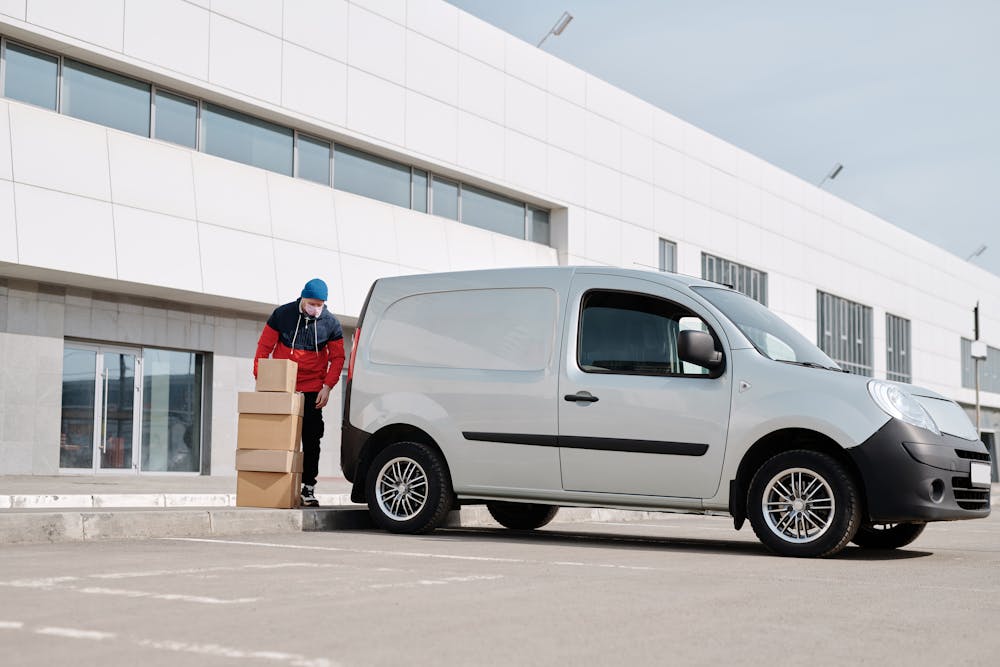Reviews
Solving Visibility Gaps with Intelligent Last Mile Courier Tracking

Accurate visibility into the final delivery stage is now essential for logistics providers striving to stay competitive. Yet many still rely on fragmented data, resulting in gaps in last mile courier tracking that raise fuel costs, delay exception handling, and decrease customer confidence without real-time updates.
The North American last mile delivery market is projected to reach USD 14.9 billion at a compound annual growth rate (CAGR) of 3.8% by 2029. This growth heightens risk because dispatchers lack complete data, finance teams absorb repeat-delivery costs, and service staff handle more status inquiries.
Therefore, as delivery windows tighten and expectations climb, intelligent last mile courier tracking solutions become vital. This guide reviews technologies, features, and implementation practices to deliver insight and improved satisfaction.
The Visibility Challenge in Last Mile Courier Tracking
As delivery volumes and customer expectations rise, many logistics teams struggle with incomplete insights into the final delivery leg. Gaps in last mile courier tracking create blind spots that drive up costs, slow response times, and weaken customer trust.
- Financial Impact
Poor route planning and unnecessary deadhead miles drive up both fuel and labor costs. When deliveries fail, or routes break down, manual exception handling and repeat runs add further administrative overhead.
- Customer Experience Decline
Vague or missed delivery windows leave recipients annoyed and drive down Customer Satisfaction Scores (CSAT). Meanwhile, a flood of “Where’s my order?” (WISMO) inquiries overwhelms support teams and chips away at brand loyalty.
- Operational Challenges
Teams spend valuable hours stitching together fragmented tracking updates instead of focusing on route optimization. Slow exception detection further reduces daily delivery capacity and makes workforce planning a constant headache.
Closing these visibility gaps is critical to controlling costs, enhancing service quality, and meeting today’s demand for real-time delivery transparency.
Why Legacy Tracking Systems Fall Short in Last Mile Courier Tracking
Traditional last mile courier tracking solutions struggle to meet modern logistics demands due to fundamental technological constraints. Here’s where they fail:
- Real-time Tracking That’s Always Behind
Fixed scan points mean no real-time view of where the package really is. That translates to lengthy gaps between updates. By the time a delay has been detected, the customer has already called to complain. Rather than remaining ahead of problems, teams are left responding after the fact.
- Inflexible Routes That Don’t Adapt to Reality
Legacy routing systems have predetermined Estimated Time of Arrival (ETA) schedules that don’t account for traffic, diversions, or inclement weather. This results in suboptimal routes, missed delivery times, and wasted fuel.
- Systems That Don’t Talk to Each Other
Transportation Management Systems (TMS), Warehouse Management Systems (WMS), and Customer Relationship Management (CRM) applications usually exist in silos. Without real-time courier visibility integration, teams manually transfer data. This inhibits decisions and a complete perspective of operations.
- Exception Management That Drains Time
Delivery problems, such as wrong addresses or delivery attempts, are still recorded manually. Escalations take time. Customers are notified too late. Without automation, employees waste time on activities that could be done more effectively.
- A Poor Customer Experience
Old ETAs and weak tracking cause customers to wonder. Many just call customer service to get an update on their order. With time, this erodes trust and prevents repeat business.
- Inefficient Costs That Add Up Quickly
From unnecessary mileage and fuel consumption to redundant trips and longer support times, the dollars of inefficiency continue to pile up. Each delay or manual patch nibbles away at the bottom line and clogs scalability.
How Intelligent Last Mile Courier Tracking Bridges Visibility Gaps
Traditional last mile courier tracking operations struggle with disconnected systems and reactive processes. Next-generation last mile carrier tracking platforms address this by combining real-time visibility, predictive analytics, and automated workflows into a single, cohesive solution.
Thereby delivering complete transparency from the distribution center to the customer’s door.
- Continuous Location Tracking
This combines GPS information with Internet of Things (IoT) sensors on both vehicles and handheld units. This last mile courier tracking feature provides parcel visibility at all times, bridging gaps between conventional scan points and giving dispatchers continuous visibility into progress.
- Adaptive Delivery Predictions
Adaptive delivery forecasts employ machine learning algorithms that combine real-time traffic behavior, weather reports, and past delivery history. They continuously update ETAs in real time, providing shoppers with very precise arrival times and minimizing “Where’s my order?” requests for efficient last mile courier tracking.
- Intelligent Exception Handling
Intelligent exception handling automatically spots issues such as stalled vehicles, access problems, or address errors. It sends immediate alerts to operations teams and recipients so that corrective actions occur before minor hiccups become major delays.
- Unified Operations View
A unified operations view integrates TMS, WMS, and CRM data into one dashboard. Dispatchers see driver locations alongside order and inventory status, simplifying coordination across teams.
- Predictive Planning
Predictive planning forecasts demand surges and optimal route density before the delivery day begins. By aligning fleet allocation, driver shifts, and micro-hub inventory to anticipated volume, organizations boost efficiency and maintain high on-time performance.
- Customer Experience Integration
Customer experience integration captures immediate post-delivery feedback and ties it directly to operational metrics. This closed-loop process turns real-time reviews into actionable insights, enabling continuous refinement of service quality.
9 Essential Features of an Intelligent Last Mile Tracking Solution
When evaluating a last mile courier tracking software, look for these nine integrated capabilities that together drive operational excellence:
| Feature | Key Capabilities |
| Driver Mobile Application | Turn-by-turn navigation with traffic-aware routing; barcode/RFID scanning and digital POD capture; secure in-app messaging |
| Central Dispatch Command Center | Real-time fleet map with geofence alerts, intelligent workload balancing, and dynamic exception-management tiles |
| Customer Visibility Portal | Branded live-tracking interface; self-service rescheduling and delivery preferences; secure one-time passcode verification |
| Smart Location Automation | Automated geofence check-ins; precision arrival notifications with live countdowns; zone-based performance analytics |
| Intelligent Exception Handling | Automated detection of RMAs, failed drops, and address errors; configurable alert escalations; closed-loop resolution tracking |
| Unified Communication Hub | Role-based messaging between drivers, dispatch, and customers; preset message templates; conversation audit trails |
| Performance Analytics Suite | OTIF, first-attempt success, and cost-per-stop metrics; driver scorecards for safety and compliance; customizable reports |
| Enterprise Integration Platform | Pre-built connectors for TMS, WMS, CRM, and ERP; API-first design with webhook support; real-time order and status sync |
| Eco-Conscious Operations Module | CO₂ emissions tracking per route/vehicle; EV-optimized routing algorithms; ESG-compliant reporting |
KPIs to Prove Courier Tracking ROI
Stronger last mile courier tracking should be reflected in hard numbers, not just more appealing maps. Use these KPIs to verify that visibility translates into fewer repeats, tighter windows, and lower unit costs. Track them weekly, tie them to targets, and attribute changes to specific launches or pilots.
- On-time In-full (OTIF)
Measures whether orders arrive within the promised window and with all items delivered. Rising OTIF indicates accurate planning, credible ETAs, and fewer exceptions that spill into support queues.
- First-attempt Success
Tracks deliveries completed on the first try. Improvements include better ETA precision, pre-arrival prompts, and self-service rescheduling, which reduce no-shows and second trips.
- Cost per Stop
Total last mile cost divided by successful stops. Declines signal higher route density, fewer reattempts, and less dwell, as well as savings from right-sizing fleets and consolidating tools.
- Miles per Stop
Average distance driven for each completed stop. Lower values show tighter territory design, effective live re-optimization, and stronger consolidation upstream.
- WISMO Rate
Share of orders that trigger “Where is My Order?” contacts. A falling rate confirms that live ETAs, proactive alerts, and clear exception messaging are reducing inbound support.
- ETA Accuracy
Difference between promised and actual arrival times, ideally tracked as MAE or MAPE. Better accuracy allows narrower windows, lifts customer satisfaction, and reduces idle curb time.
- Exception Resolution Time
Elapsed time from issue detection to closure. Faster resolution demonstrates that automated triage, clear ownership, and integrated workflows are removing manual handoffs.
Get Started with Intelligent Last Mile Tracking
Effective last mile courier tracking is key to controlling costs, boosting operational efficiency, and enhancing customer loyalty. Implement a unified, API-first platform that delivers real-time GPS visibility, dynamic routing, predictive ETAs for last mile, and automated exception management to optimize every delivery.
Measure metrics like OTIF, first-attempt success, cost per stop, and NPS to enable continuous refinement and accountability across teams. Partnering with technology partners such as FarEye ensures seamless integration with existing systems, end-to-end transparency, and rapid deployment. Take the next step: pilot an intelligent tracking solution on your most challenging routes and transform your last mile operations into a sustainable competitive advantage.
FAQ’s
- What is last-mile courier tracking?
Last mile courier tracking is a real-time view of the final leg that unifies GPS, scan events, driver-app signals, and geofences into one canonical operational timeline. It publishes live ETAs, statuses, and exception flags to dispatch, support, and customer links, with ePOD capture, comprehensive audit trails, and analytics-ready exports.
- Which KPIs prove ROI for courier tracking?
Prove ROI with OTIF, first-attempt success, cost per stop, miles per stop, WISMO rate, ETA accuracy, and exception resolution time. Track weekly, compare against a baseline cohort, and attribute movements to launches such as live re-optimization, address intelligence, self-service rescheduling, driver coaching, and standardized returns workflows across regions.
- How is courier tracking different from carrier tracking?
Courier tracking focuses on your own delivery operations, drivers, and stops. Carrier tracking aggregates third-party networks and milestones. Many enterprises need both systems. Unify them in one control tower so ETAs, exceptions, and proof of delivery stay consistent for planners, drivers, and customers across owned fleets and contracted partners.
- Can we integrate tracking with TMS/WMS/CRM?
Yes. Modern platforms integrate with TMS, WMS, and CRM systems using REST APIs and webhooks to track orders, events, and statuses. Streaming connectors feed analytics warehouses. SSO, RBAC, and audit logs protect access. Sandboxes and feature flags enable safe rollouts while minimizing disruption to existing workflows and downstream operational systems.
- How fast do teams see results?
Results vary by data quality, adoption, and volume mix. Directionally, WISMO and missed-delivery noise often decline within a few weeks once live ETAs and self-service links are enabled. Larger gains like lower cost per stop and tighter ETA windows typically emerge after a focused four to eight-week pilot.

-

 World5 days ago
World5 days agoCargo plane plunges into sea at Hong Kong airport; 2 killed
-

 Business1 week ago
Business1 week agoYouTube restores service after widespread global outage
-

 Legal4 days ago
Legal4 days agoMan armed with AR-15 arrested after threats to ‘shoot up’ Atlanta airport
-

 Health5 days ago
Health5 days agoMexico reports new human case of H5 bird flu
-

 World4 days ago
World4 days agoMagnitude 5.0 earthquake rattles Dominican Republic
-

 World1 week ago
World1 week agoCar bomb explodes near shopping mall in Ecuador’s largest city
-

 World7 days ago
World7 days agoEstonia permanently closes road through Russian territory
-

 World1 week ago
World1 week agoU.S. Special Operations helicopters spotted near Venezuela




